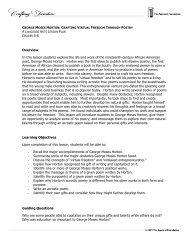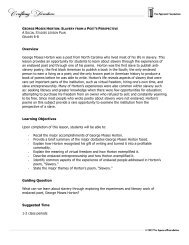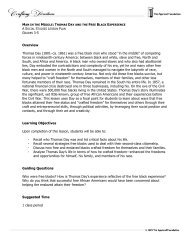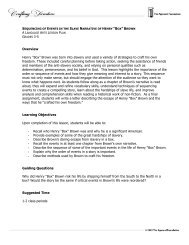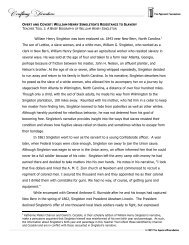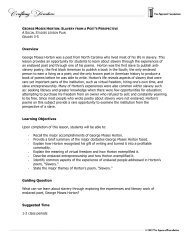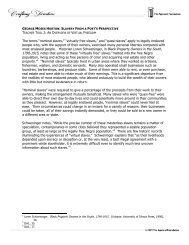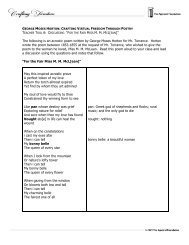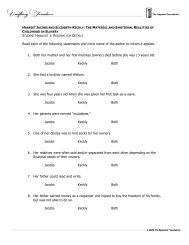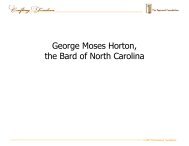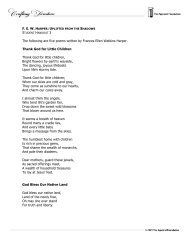Overview In this lesson, students will learn that ... - Crafting Freedom
Overview In this lesson, students will learn that ... - Crafting Freedom
Overview In this lesson, students will learn that ... - Crafting Freedom
Create successful ePaper yourself
Turn your PDF publications into a flip-book with our unique Google optimized e-Paper software.
<br />
mention <strong>that</strong> as a boy, Singleton also resisted slavery by hiding and pretending to be<br />
ignorant. When he grew up, he also assisted and served in the Union Army.<br />
6. After reading the excerpt from Singleton’s narrative, show <strong>students</strong> the distance (over<br />
500 miles) on your classroom map or have them look it up on MapQuest. Think of local<br />
points of interest, like your school to the closest movie theater or shopping mall, and tell<br />
them how many miles are between those two places. Ask them to imagine walking all<br />
<strong>that</strong> way. What would <strong>that</strong> be like? Ask them to imagine doing so before there were<br />
good roads and when they were trying to hide to avoid being caught and returned to<br />
slavery. What would <strong>that</strong> feel like? Have them imagine making <strong>that</strong> journey without<br />
money or other resources and all alone as a young child. Ask them what kinds of<br />
feelings would they have? Now, ask them to multiply <strong>that</strong> distance by how ever many<br />
times it would take to get to the more than 500 miles <strong>that</strong> Singleton traveled. Ask them<br />
to imagine traveling <strong>that</strong> whole distance at so young an age and with so little assistance.<br />
7. Explain to <strong>students</strong> <strong>that</strong> Singleton was one of many people who ran away from slavery.<br />
Either project or distribute printed copies of the runaway slave ads <strong>that</strong> you preselected.<br />
Discuss the runaway slave ads to help <strong>students</strong> “get into character” and to empathize<br />
with the feelings of a fugitive boy on the run and fearing capture by those seeking a<br />
reward. Distribute the Student Handout 2, which outlines their Diary Writing<br />
Assignment.<br />
Assessment (Optional)<br />
The Diary Writing Assignment created during the <strong>lesson</strong> would be appropriate to assess<br />
<strong>students</strong>’ understanding of a fugitive slave’s life. A rubric is provided to assess the assignment.<br />
Extending the Lesson<br />
Read or have <strong>students</strong> read other parts of William Henry Singleton’s narrative <strong>that</strong> describe his<br />
childhood resistance experiences. Have <strong>students</strong> write diary entries about these other<br />
experiences from Singleton’s perspective and in his voice. You can note the various ways <strong>that</strong><br />
Singleton resisted slavery (running away, hiding, pretending to be ignorant, and assisting and<br />
serving in the Union Army) in Teacher Tool 3, which provides the full text of his narrative with<br />
notes on the right to identify the type of resistance next to the bold passages on the left.<br />
Present some examples of injustice to your <strong>students</strong>, including the institution of slavery.<br />
Discuss the ways <strong>that</strong> the injustice might be resisted and why it is important to understand <strong>that</strong><br />
there is more than one way to resist injustice. Be sure to discuss how <strong>students</strong> might identify<br />
something as unjust. Lead a discussion about what circumstances call for resistance. Ask them<br />
to consider several things when thinking about appropriate ways to resist. Students should<br />
consider: why they want to resist; whether resisting is worth the possible consequences; what<br />
is the goal of resisting; what are some of the options for how to resist; and, which way they<br />
would choose (and why).<br />
After familiarizing <strong>students</strong> with a broad array of runaway slave advertisements and exposing<br />
them to the experiences of fugitive slaves (including such <strong>Freedom</strong> Crafters as William Henry<br />
Singleton, Harriet Jacobs, and Henry “Box” Brown), ask <strong>students</strong> to create a fictional short story<br />
in which they depict an enslaved child who runs away from his or her owner. Encourage them<br />
to select various sources of input and experiences for <strong>this</strong> fiction writing assignment from the




